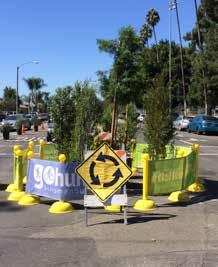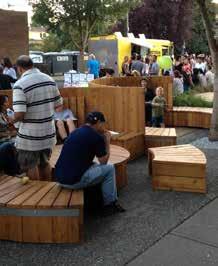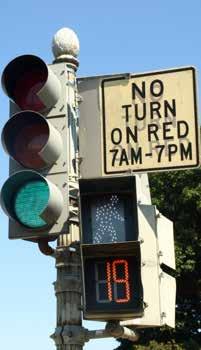
6 minute read
Figure 4-4: Strategy to Reduce Crime and Reduce Fear that Reduces Transit Ridership15
Development and redevelopment projects by local jurisdictions within the walkshed of a bus stop should also be reviewed for opportunities to rebuild damaged sidewalks or construct new ones where gaps exist, to provide more direct pedestrian networks, or improve the safety and environment of the overall pedestrian experience.13
In some cases, residents have opposed specific transit services, such as new lines and stations in their neighborhood, due to fears that improving low-income people’s access will increase crime rates.15 Several before-and-after studies indicate that new transit services do not generally increase total crime rates.15 They may attract more people and business activity which may increase local crimes, but crimes per transit passenger, total regional crime, and risks to individuals rarely increase.15
Advertisement
lighting for Personal Safety
Adequate lighting is one component to safety and security at bus stops. Omnitrans has been working to install hundreds of pole-mounted solar lights at bus stops throughout the system. When existing streetlights do not provide adequate lighting and solar lights are lacking, proper lighting should be provided to ensure the safety and security of all transit riders.13 In addition, bus stops should be visible from nearby buildings, roads, near crosswalks, and well-lit so passersby can help monitor the bus stop.
Visibility for Personal Safety
The concept of putting more “eyes on the street” from passing cars, building windows and walkways can create a greater sense of safety at a bus stop. This extends to sightlines in and around a bus stop and requires special attention for a personal sense of safety and security.13
For example, the Omnitrans Transit Design Guidelines (2013) includes additional transparent shelters for their bus stops. Transparent materials are also important because it allows someone approaching the bus stop to see if another person is hiding behind a shelter panel and might jump out at them. Similarly, bushes near a bus stop are discouraged if there is potential for someone to hide behind them.19 Surveillance cameras can be used if crime is an issue at an existing bus stop as it may have a deterrent effect on crime.14
Positive security cycle
Communities tend to become safer as more non-criminals walk, bike, and use public transit, and develop is more compact and mixed, creating a positive feedback cycle.
Increased perception of safety and social acceptability of urban living
Reduced crime/ increased safety More responsible urban residents, pedestrian and public transit users
Improved urban services, including better urban transport
Improved economic opportunity for at-risk residents FIGURE 4-4: Strategy to Reduce Crime and Reduce Fear that Reduces Transit Ridership15
Bus stop facility modifications to improve personal safety may continue to include: » Continue to provide signage, seating, shelters, and trash receptacles at more bus stops.11 » Increasing maintenance (frequency and thoroughness)11 » Provide amenities based on the expected rider types (elderly need more benches, etc.). » Security cameras, emergency phones, and public announcement systems at locations with the most safety concerns. » Local jurisdictions should add and maintain trees for shade without compromising bus stop function or accessibility.
Community Outreach
Transit agencies can assess existing conditions for pedestrian safety near transit stops and stations with help from the community. Note that Omnitrans already has many of these programs in place.
Continue existing programs:
» “Adopt-A-Stop” programs with riders and businesses.11 » Encouraging residents to report safety issues.11
Explore implementing the following programs:
» Encourage the creation of community task forces for new construction and redevelopment projects.11 » Encourage community participation in project advisory committees.11 » Encourage resident participation in community safety teams.11 » Enlist community help with transit accessibility audits.11 » Develop quick reference phone lists for residents to contact the appropriate person.11 » Develop easy-to-use websites with information directed at community groups.11
Placemaking and Space Activation
Placemaking to increase personal safety and quality of life at bus stops is the idea of integrating the bus stop into an attractive destination for people to meet and socialize while patronizing adjacent centers of activity and be part of a person’s full day’s journey - instead of just a bench and a ride to start your day’s activities. The bus stop can become a positive focal point for a street or small neighborhood. There is potential for secondary effects like improved economic activity near the bus stop that increases overall sense of safety and security for everyone.
A major aspect of placemaking is partnering with the surrounding community to help identify positive features and activities in a small area that is being considered for a bus stop. The process starts with community coordination to find positive existing assets near a bus stop to build upon and make an overall positive experience for the bus rider. Walkability, safe connected sidewalks, wayfinding signage, an events calendar or suggestions of things to do near the bus stop all contribute to placemaking and attracting people to use transit.
Place-building activities near a bus stop typically include small parks, coffee shops, restaurant, entertainment centers, a blank wall that gets a locally developed mural or sculpture, and local efforts to paint or wrap city-owned utility boxes with art as shown in the samples to the right. Omnitrans riders may find this concept familiar as several Omnitrans member cities have utility box art and mural programs in place. This can increase a local community’s sense of ownership of the streetscape and bus stop. Adopt-a-stop and adopt-a-litter-container programs can help neighbors build a sense of place around a bus stop and reduce fear of crime at a bus stop.


SCAG’s Go Human Demonstration Parklet Mural on side of building

4.5.2 Signal Timing Best practice for signal timing involves reducing travel time for both buses and for transit users walking to bus stops, leading to less wait time and higher levels of comfort. The top three best practice measures for Bus Stop Safety signal timing are:
Transit Signal Priority (TSP)
TSP is a technique to improve service and reduce delay for mass transit vehicles at intersections controlled by traffic signals. The recommendation is to continue to use TSP where feasible. Omnitrans is already using TSP, as shown in the 2014 TSP evaluation conducted by Iteris.
leading Pedestrian Intervals (lPI)
A LPI is a signal timing technique that allows a “head start” for people walking. It gives people walking exclusive access to a crosswalk, typically three to seven seconds, before vehicular traffic is permitted. LPIs are known to have among the highest benefit-cost ratio of any pedestrian safety mitigation measure.
Right-Turn-On-Red (ROTR) Restrictions
No RTOR improves safety for people walking by not allowing motorists to turn right when the signal is red. No RTOR restrictions are in place city-wide in New York City and are common across the country in cities like Boston and Somerville, Massachusetts, using signing. It was standard practice across the country until the 1970s.
Leading pedestrian interval
Source: FHWA No right turn on red sign

Source: PedSafe - FHWA





